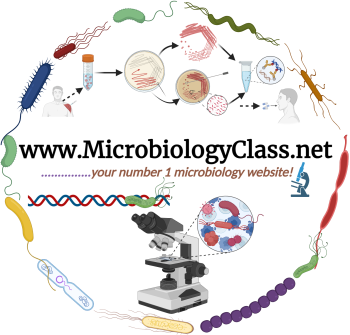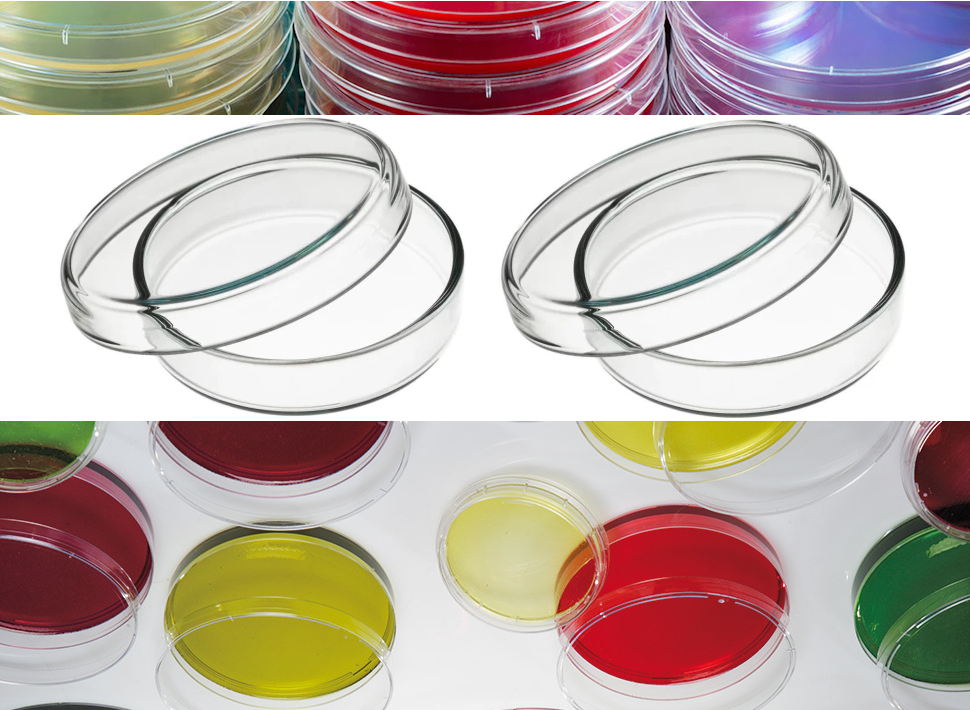Desoxycholate Citrate Agar (DCA) is a selective medium for the isolation of Salmonella and Shigella organisms. It is ideal for the investigation of pathogenic Enterobacteria. The Gram-positive organisms are totally inhibited by the sodium citrate and sodium desoxycholate in the medium. Proteus and coliforms are also highly inhibited.
Salmonella typhi, S. paratyphi and Shigella species yield colourless (lactose-negative) colonies while lactose positive organisms like E. coli are pink to red on DCA. This is due to the neutral red in which presence lactose fermenting bacteria form red colonies while non-fermenting colonies or bacteria will appear clear, with or without black centers. Lactose fermenting colonies mass have a desoxycholate precipitation zone around them.
DCA is inhibitory to most gut bacteria, in particular species of the genus Proteus, although these species do survive on DCA agar. It is therefore essential that suspected pathogens must be subcultured on a less inhibitory medium prior to identification. Salmonella spp appear to be yellow or colourless colonies, often with a dark centre.
As there are many bacteria that also look like Salmonella on DCA, it is widely recommended that more selective agars are used for the identification of Salmonella, namely xylose lysine deoxycholate (XLD) agar. This growth medium is heat-sensitive and should be poured and cooled as soon as possible after addition of the deoxycholate, otherwise it tends to become very soft and difficult to handle. It has a pH of approximately 7.3, and when poured and cooled, appears light to dark pink in colour.
Composition of DCA medium
| Typical Formula* | gm/litre |
| `Lab-Lemco’ Powder | 5.0 |
| Peptone | 5.0 |
| Lactose | 10.0 |
| Sodium citrate | 8.5 |
| Sodium thiosulphate | 5.4 |
| Ferric ammonium citrate | 1.0 |
| Sodium desoxycholate | 5.0 |
| Neutral red | 0.02 |
| Agar | 12.0 |
| pH 7.3 ± 0.2 @ 25°C |
Directions for use per Liter:
Suspend 73g in 1L of deionized water. Heat with frequent agitation and boil for one minute to completely dissolve the medium. AVOID OVERHEATING. Pour plates can be prepared after the medium has been cooled to 45-50°C. Do not autoclave.
Storage and Stability:
Store powdered media at room temperature (RT). Opened bottles should be capped tightly and kept in a dark, low humidity environment. Prepared media should be kept at 4°C and used within a short period of time.
Caution: DCA MEDIUM is heat sensitive: avoid excessive or prolonged heating during reconstitution. Do not autoclave or re-melt.
Technique for usage of DCA MEDIUMInoculate the medium heavily with faeces or rectal swabs, spreading part of the original inoculum in order to obtain well separated colonies on some portion of the plate. Incubate for 18-24 hours at 35°C. If organisms are late developers or if no non-lactose fermenters are observed, incubate for a further 24 hours.
Colonies may be picked directly off the medium for serological and biochemical tests. It should be noted that Escherichia coli survives on the medium even though it does not usually grow – therefore colonial purity should be established by subculture on to a differential but less inhibitory medium, e.g. MacConkey Agar CM0007.
Colonial characteristics ON DCA medium(Following incubation at 35°C.)
The medium is clear and pale pink. Lactose fermenting organisms produce pink colonies and may be surrounded by a zone of precipitated desoxycholic acid, which is due to acid production. The colonies of non-lactose fermenters are colourless, and due to their alkaline reaction they are surrounded by a clear orange-yellow zone of medium.
Escherichia coli – Most strains are inhibited, but the few strains which grow produce pink umbilicated colonies 1-2mm in diameter which may be surrounded by a zone of precipitation.
Shigella sonnei – the colonies are 1mm diameter after 18 hours incubation, and 2mm after 38 hours; they are smooth and initially colourless, becoming pale pink on further incubation due to late lactose fermentation.
Shigella flexneri – colonies are colourless and similar in appearance to those of Shigella sonnei, but often with a narrow plane periphery round a central dome.
Salmonella paratyphi B – from 1mm diameter after 18 hours incubation to 2-4mm on the second day, when they are slightly opaque, dome-shaped, with a central black dot.
Salmonella typhi – 0.25-1mm in diameter after 18 hours and pale pink, a day later they are flat, conical, 2mm in diameter, colourless and slightly opaque, often with a central grey dot.
Other Salmonella colonies – similar to those of Salmonella paratyphi B. Non-pathogenic non-lactose fermenters, such as Proteus and Pseudomonas species, grow on the medium and may produce colonies which closely simulate those of the salmonellae or shigellae. Proteus colonies are often glossy (more translucent than those of the pathogens), with a large central black dot and a `fishy’ odour.
Storage conditions and Shelf lifeStore the dehydrated medium at 10-30°C and use before the expiry date on the label.
Store the prepared agar plates at 2-8°C.
AppearanceDehydrated medium: Straw/pink coloured, free-flowing powder
Prepared medium: Pink coloured gel
Quality control
| Positive controls: | Expected results |
| Salmonella typhimurium ATCC® 14028 * | Good growth; straw coloured colonies with black centres |
| Shigella sonnei ATCC® 25931 * | Good growth; straw coloured colonies |
| Salmonella nottingham NCTC 7832 * | Good growth; straw coloured colonies with black centres |
| Negative control: | |
| Enterococcus faecalis ATCC® 29212 * | No growth |
Source:
www.oxoid.com/UK/blue/prod_detail/prod_detail.asp?pr=cm0227&c=UK&lang=EN
www.medical-labs.net/desoxycholate-citrate-agar-dca-2746/
Discover more from Microbiology Class
Subscribe to get the latest posts sent to your email.




